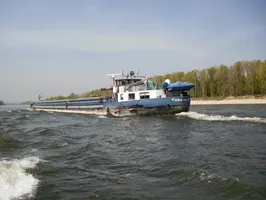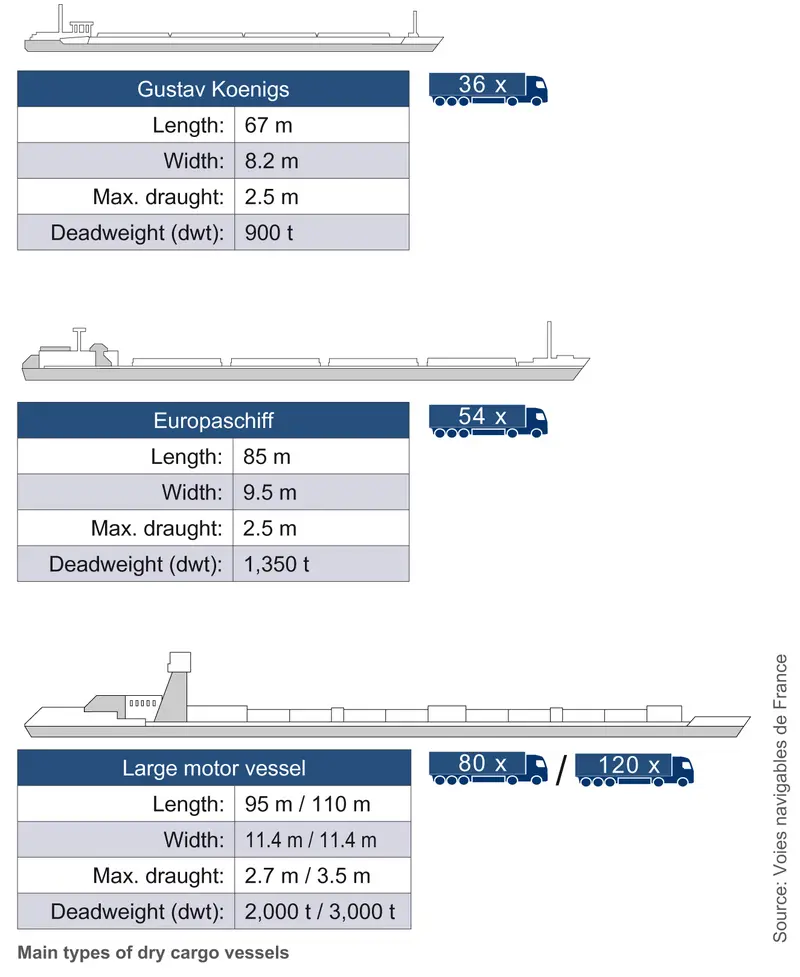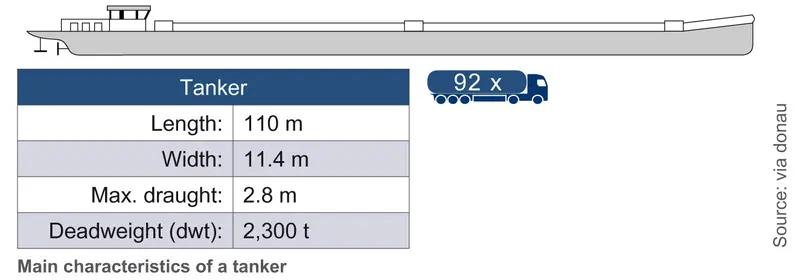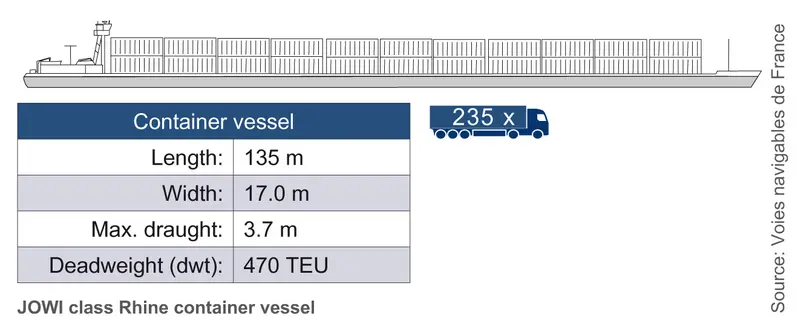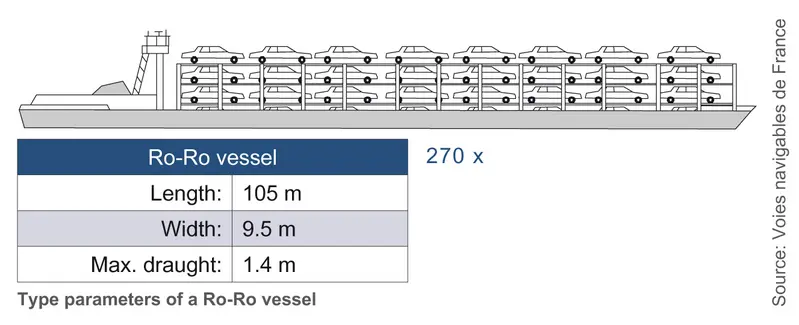Depending on the combination of their propulsion systems and cargo holds, basically three types of cargo vessels are used on the Danube and its navigable tributaries:
- Motor cargo vessels (or "self-propelled vessels") are equipped with an engine and a cargo hold. Motor cargo vessels can be subdivided into dry cargo vessels, tankers, container vessels and Ro-Ro vessels (see below "Main types of vessels according to cargo type")
- Pushed convoys consist of a pusher (motorised vessel used for pushing) and one or more non-motorised pushed lighters that are firmly attached to the pushing unit. We talk about a coupled formation or pushed-coupled convoy if a motor cargo vessel is used for propelling the formation or convoy instead of a pusher.
Pushed navigation on the danube
Cargo shipping on the Danube is predominantly carried out by means of convoys (pushed convoys, coupled formations as well as pushed-coupled convoys), and only a small share by individual motor cargo vessels. On the Rhine, the ratio of convoys to motor cargo vessels is approximately the reverse.
The basic rule for the formation of convoys is: vessel units in pushed convoys are grouped so as to reduce water resistance when in motion as much as possible or so that sufficient stop and manoeuvre characteristics can be ensured (e.g. when navigating downstream). In order to lessen the resistance, the lighters are placed in a staggered arrangement towards the rear.
If the appropriate technical features of the units used in a convoy allow it, vessel units are not attached to one another rigidly, but rather coupled with flexible connectors to enable the convoy to negotiate curves in areas with particularly narrow curve radii. For upstream travel, the convoy should have as small a cross-sectional area as possible and thus the lowest possible resistance, which is why the lighters are arranged next to each other together when travelling downstream, to facilitate the manoeuvrability of the convoy and most especially its ability to stop in the direction of the current.
- Tugs are used to tow non-motorised vessel units, so-called barges (vessels for carriage of goods with a helm for steering). Towed convoys are rarely used on the Danube anymore because they are less cost-effective than pushed convoys.
Main types of vessels according to cargo type
Types of cargo vessels can be further characterised based on cargo types.
Dry cargo vessels
Dry cargo vessels are used for transporting a wide variety of goods including log wood, steel coils, grain and ore. These vessels can be used for almost anything and therefore reduce the number of empty runs (journeys with no return cargo). This class of vessel can generally carry between 1,000 and 2,000 tons of goods and is often used on the Danube in coupled formations or pushed-coupled convoys. Dry cargo vessels can be divided into the three main classes that are shown in the enclosed figure.
Tankers
Tankers transport various types of liquid goods, such as mineral oil and derivates (petrol, diesel, heating oil), chemical products (acids, bases, benzene, styrene, methanol) or liquid gas. The majority of the liquid goods mentioned above are hazardous goods which are transported using special tanker vessel units equipped with the appropriate safety devices. European regulations and recommendations, such as the ADN and ADN-D, as well as national legislation governing the transport of hazardous goods have particular relevance in this context.
Tankers used on the Danube have an average loading capacity of around 2,000 tons. As is the case with the navigation of dry cargoes, the transport of liquid goods on the Danube is carried out primarily by pushed convoys.
Modern tankers have a double hull which prevents the cargo from leaking in the event that the outer hull is damaged. Stainless steel tanks or cargo holds with a special coating are used in order to prevent the cargo from reacting with the surface of the tank. The use of heaters and valves enable the transport of goods that freeze easily even in winter, and sprinkler systems on deck protect the tanks from the summer heat. Liquid gases are transported under pressure and in a cooled state using special containers. Most tankers have pumps on board which can load and unload the goods directly into the tanks in ports not equipped with such special loading systems.
Container vessels
Container vessels are ships constructed specifically for the transport of containers and are currently used primarily in the Rhine region. In the Danube region container convoys with four pushed lighters are regarded as the best way to increase capacity. Such a pushed convoy has a total loading capacity of up to 576 TEU – each pushed lighter can therefore carry 144 TEU, i.e. three layers of containers with 48 TEU each.
RoRo vessels
Roll-on-Roll-off means that the goods being transported can be loaded and unloaded using their own motive power via port or vessel ramps. The most important types of goods transported in this way include passenger cars, construction and agricultural machinery, articulated vehicles and semi-trailers (“floating road”) as well as heavy cargo and oversized goods.
The majority of Ro-Ro transport operations are carried out with specially constructed vessels such as catamarans. Catamarans are vessels with a double hull in which the two hulls are connected by the deck, which forms a large loading surface for the rolling goods.

